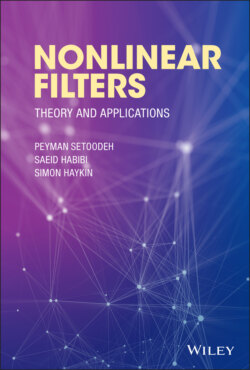Читать книгу Nonlinear Filters - Simon Haykin - Страница 27
2.6.2 Discrete‐Time Nonlinear Systems
ОглавлениеThe state‐space model of a discrete‐time nonlinear system is represented by the following system of nonlinear equations:
(2.78)
(2.79)
where is the system function, and is the measurement function. Similar to the discrete‐time linear case, starting from the initial cycle, system's output vectors at successive cycles till cycle can be written based on the initial state and input vectors as follows:
(2.80)
Functional powers of the system function can be used to simplify the notation in the aforementioned equations. Functional powers are obtained by repeated composition of a function with itself:
(2.81)
where denotes the function‐composition operator: , and is the identity map. Alternatively, the difference equations in (2.80) can be rewritten as:
(2.82)
Similar to the continuous‐time case, the system of nonlinear difference equations in (2.82) can be linearized about the initial state based on the Taylor series expansion to develop a linearized test for weak local observability of the nonlinear discrete‐time system (2.78) and (2.79). The nonlinear system in (2.78) and (2.79) is locally weakly observable at , if there exist a neighborhood of and an ‐tuple of integers such that [9, 25]:
1 for .
2 The following observability matrix is full rank:(2.83)
where
(2.84)
The observability matrix for discrete‐time linear systems (2.22) is a special case of the observability matrix for discrete‐time nonlinear systems (2.83). In other words, if and are linear functions, then (2.83) will be reduced to (2.22) [9, 25].
